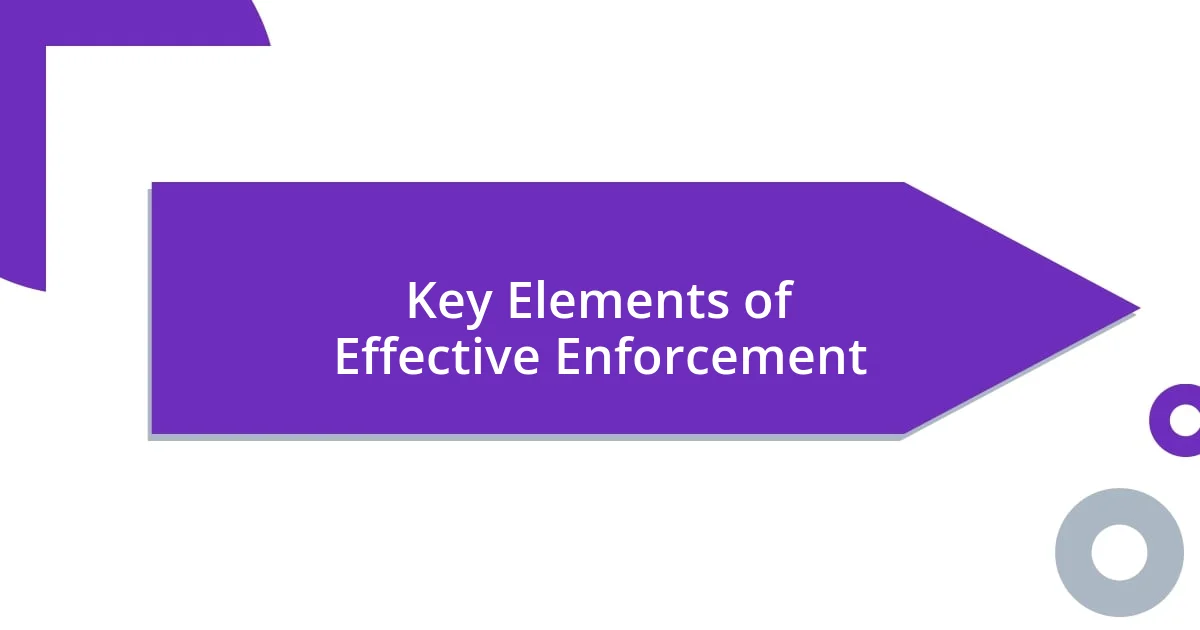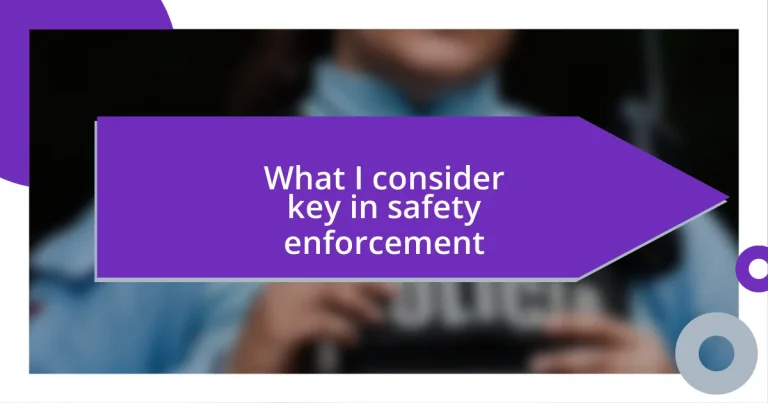Key takeaways:
- Safety enforcement fosters accountability and a culture where individuals prioritize their well-being and that of others, transforming workplace dynamics.
- Continuous training and clear communication enhance safety practices, making protocols relevant and increasing engagement among employees.
- Measuring compliance through feedback and celebrating safety milestones cultivates a shared commitment to safety and motivates ongoing participation in safety initiatives.

Importance of Safety Enforcement
Safety enforcement is crucial because it creates an environment where individuals can perform their roles without fear of accidents or harm. I recall a time during a safety training session at my workplace when a colleague shared how a minor lapse in safety protocols led to a near-miss incident. It made me realize that one small oversight can have significant consequences, sparking a deep sense of responsibility in all of us.
The emotional weight of safety enforcement often goes unnoticed until something adverse occurs. Have you ever stopped to think about how relentless safety checks can save lives? I’ve seen the relief on a supervisor’s face after ensuring every precaution is taken; their dedication reminds me that we are all in this together. It’s more than just rules; it’s about people—we want our loved ones to return home safe every day.
Furthermore, safety enforcement fosters a culture of accountability, encouraging everyone to prioritize their well-being and that of others. I remember when we implemented a peer-review safety program; it transformed our dynamic. Suddenly, we weren’t just checking boxes; we were looking out for one another, creating a strong sense of community that ultimately makes us all safer. Wouldn’t it be great if everyone felt that same sense of duty?

Understanding Safety Regulations
Understanding safety regulations is an essential aspect of creating a secure work environment. From my own experience, I remember attending a compliance workshop where an expert explained the difference between local and national safety regulations. The way she broke it down made it clear that while overarching laws provide a framework, local regulations often address specific community needs. This revelation opened my eyes to how nuanced safety enforcement can be.
When diving deeper into regulatory details, I found it fascinating how these guidelines impact daily operations. For instance, during site inspections, I’ve learned that adhering to codes isn’t merely about ticking off boxes; it’s about safeguarding people’s lives. One memorable moment was when we narrowly avoided an accident because we followed an obscure but crucial regulation about equipment maintenance. It drove home the point that attention to safety regulations isn’t just a bureaucratic task; it can be a matter of life and death.
Navigating these safety regulations can feel overwhelming at times, but I’ve learned that breaking them down into manageable parts is crucial. Think about it: having a checklist can transform a complex regulatory landscape into clear actionable steps. During a project kickoff, our team created a visual roadmap of compliance requirements, which not only eased our workload but also fostered collective accountability. Wouldn’t it be uplifting to see more teams taking similar initiatives for a safer workplace?
| Aspect | Description |
|---|---|
| Local Regulations | Address specific community needs and circumstances. |
| National Regulations | Provide a broader legal framework for safety practices. |
| Importance of Compliance | Compliance can prevent accidents and ensure worker safety. |
| Framework vs. Specifics | While broad laws exist, specifics may vary by location. |
| Safety Checklists | Transform complex regulations into manageable tasks. |

Key Elements of Effective Enforcement
Effective enforcement relies on several core elements that create a robust safety culture. I’ve seen firsthand how clear communication is foundational to success. In one instance, during a monthly safety meeting, our team openly discussed our high-profile incidents, allowing everyone to voice their concerns and insights. This transparency not only improved our protocols but also fostered trust among colleagues. It’s amazing how when people feel heard, they’re more likely to engage actively in safety practices.
Here are some key elements that I consider essential for effective enforcement:
- Clear Procedures: Well-defined protocols ensure everyone knows what to do in various situations.
- Regular Training: Ongoing education helps reinforce safety principles and keep them fresh in minds.
- Open Communication: Encouraging feedback creates a culture of vigilance and improvement.
- Accountability: Establishing responsibility ensures everyone understands their pivotal role in safety.
- Visible Leadership: Leadership actively participating in safety initiatives demonstrates commitment and motivates others.
Reflecting on my own experiences, I’ve realized how essential it is to embrace a proactive mindset. There was a time when a near-miss incident struck my team, spurring us to initiate a series of team-building exercises focused on safety. We found that sharing stories of past incidents fostered connection and a sense of urgency. Seeing my colleagues engaged not only made me feel we were in this together but also inspired me to think creatively about enforcement strategies that truly resonate at a personal level.

Role of Training in Safety
Training plays a pivotal role in safety enforcement; it’s where theory meets practice. I remember my first hands-on safety training session—it transformed my understanding of protocols. Suddenly, the manuals I had read came to life. I could see how each piece connected to real-world situations, reinforcing the importance of procedures we often take for granted. Have you ever felt that spark of realization when something finally clicks?
During regular training sessions, I’ve observed a remarkable shift in attitude among my colleagues. It’s fascinating how interactive demonstrations cultivate a deeper appreciation for safety measures. In one session, we simulated an emergency evacuation. The adrenaline was palpable, and I could see my peers truly grasping the urgency of our safety protocols. This experience reminded me that training isn’t just about compliance; it’s a chance to foster a sense of community and shared responsibility towards safety.
Moreover, continuous training lets us adapt to evolving situations and technologies. I recall a moment when we were introduced to a new piece of safety equipment. An instructor not only walked us through the operation but also emphasized potential hazards if misused. It struck me how essential ongoing education is; without it, we risk becoming complacent. Are we really prepared for the unexpected if we aren’t routinely updating our skills? This realization motivates me to advocate for more frequent training opportunities in every organization I’m part of.

Measuring Compliance and Effectiveness
Measuring compliance and effectiveness in safety enforcement is crucial for understanding how well protocols are followed and how they impact overall safety culture. From my experience, I find it helpful to utilize metrics that track incident rates alongside compliance checks. I once implemented a simple yet effective method: we created a compliance scorecard to spotlight areas for improvement. It was eye-opening to see the correlation between compliance levels and incident reduction within a few months. This approach not only motivated the team but made safety data almost tangible.
Another aspect I’ve come to appreciate is the importance of employee feedback during assessments. I vividly remember a time when we conducted anonymous surveys after safety drills. The insights we gained were invaluable! Colleagues pointed out minor adjustments that could make procedures smoother—things I hadn’t even considered. It made me wonder: How many opportunities for improvement are we overlooking simply because we don’t ask? Engaging employees in this way cultivates an environment where safety becomes everyone’s responsibility.
Finally, I’ve learned that the effectiveness of safety enforcement isn’t just about numbers; it’s about the narrative behind them. Reflecting on various enforcement strategies, I’ve seen that sharing success stories—like when a department achieved zero accidents for an entire quarter—creates a powerful incentive for compliance. Those moments resonate deeply and inspire others to elevate their own safety practices. Are we sharing enough of those stories to keep motivation high? It’s something worthy of consideration as we aim to foster a more vigilant safety culture.

Feedback Mechanisms for Improvement
Receiving feedback can often feel daunting, yet it has the potential to be transformative. I recall a time when we initiated a post-incident review protocol. It was a simple process—gathering everyone involved to discuss what went wrong and what actions could improve our response. The honesty during these discussions was refreshing, and I was struck by how open my colleagues were in sharing their perspectives, which helped us identify gaps in our safety procedures. Isn’t it interesting how a supportive environment can make all the difference when addressing sensitive issues?
In my experience, one of the most effective feedback mechanisms has been regular check-ins with team members. During these informal gatherings, I intentionally create an atmosphere where everyone feels their voice matters. On one occasion, an employee mentioned feeling hesitant to report minor safety concerns. That feedback led us to re-evaluate our reporting protocols and ultimately foster a culture where small insights are valued. When was the last time you made an effort to listen, truly listen, to those around you?
Moreover, I’ve seen technology play an essential role in gathering feedback. Implementing a digital suggestion box made it easier for team members to share their thoughts anonymously. I remember scanning through the submissions one day and finding an idea that would streamline our safety checks. It’s incredible how a simple mechanism can open up avenues for innovation. I wonder, are we leveraging technology effectively enough to encourage open dialogue? Establishing such systems can enhance our approach to safety enforcement in ways we might not have considered before.

Building a Safety Culture
Building a safety culture involves fostering an environment where everyone feels accountable for their own safety and that of their colleagues. I remember when our management team decided to hold regular safety huddles, where we would discuss our near misses and share lessons learned. At first, it felt a bit awkward, but gradually, we all began to look forward to these sessions. It created a space where vulnerability was welcomed, and that openness empowered each person to contribute meaningfully to our culture of safety. Doesn’t it feel invigorating when people speak up, knowing they’re part of something bigger?
Another compelling aspect of building a safety culture is leadership’s role in modeling safe behaviors. I can’t stress enough how impactful it was when our supervisors began participating in safety drills alongside their teams. Seeing them engage genuinely made a significant difference; it reinforced that safety wasn’t just a box to check but a heartfelt commitment. This approach transformed our dynamics—everyone started to mirror that dedication. It really made me rethink: How often do we, as leaders, actively demonstrate our values rather than just preach them?
Moreover, celebrating safety milestones can elevate the entire culture. During one quarter, our department reached 100 days without an accident. We organized a small celebration, complete with recognition for team members who went above and beyond. The joy in the room was palpable! I think back to that event and wonder, do we take these moments to celebrate victories big and small? Recognizing achievements doesn’t just boost morale; it solidifies the idea that safety is a shared journey—one that we’re all in together.














